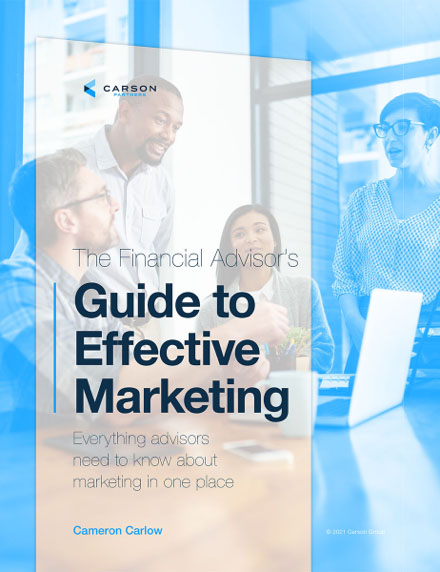Look out across the digital landscape. Prospects are out there, waiting to be claimed. But how do you get them to come to you?
Do you have a digital marketing starter pack?
Maybe you just started an advisory firm and have been too busy setting up your new clients. Maybe you’re part of an established firm who hasn’t made the transition to the digital age. Or maybe you’re so overwhelmed managing other parts of your business that you let marketing take a back seat.
Whatever the situation, you’re ready to start building your online presence now. It’s time to get in place the essential pieces, like your website, blog, social media and retargeting ads – your digital marketing starter pack.
Website
Your website is the digital version of your office, a virtual front door beckoning to prospects. Nowadays, if you don’t have a website, you might as well not have a physical office – it’s that important.
Your website doesn’t have to be the Michael Jordan of the internet, but it should have these fundamentals:
- Three Pages (Home, About Us, Contact) – Of course, your website should eventually have a little more substance, but creating a homepage, “About Us” page and contact page is a good starting point. These pages are essential. Without them, you can’t go on to attract real clients. After you lay down these building blocks, you are free to decorate your digital office with more information and personality.
- Responsiveness – In today’s technology-driven world, more people access the internet on mobile devices than computers. A responsive website looks different based on what device you’re using. Computer users usually get the full version and mobile users see a simplified one. Have you ever visited a non-responsive website on your iPhone? Chances are, it frustrated you – even to the point of clicking off. Most web designers have standard responsiveness options, but the advisory industry is still full of non-mobile friendly websites. Make sure yours is accessible and user-friendly.
- Calls to Action – This is a fancy name for buttons that allow web visitors to engage with your site. Without them, your website might as well be an ad on a bus bench – static. We have nothing against bus bench ads, but there’s nothing interactive about them. The great thing about a website is you can engage with it. Make sure to include buttons that lead to your contact page and social media accounts or, if you have content, point visitors toward downloadable resources and other helpful tools.
Blog
If a website is your virtual office, your blog is your virtual personality. It gives prospects and clients the chance to find out who you are, what you stand for and how you see current industry trends. You don’t have to write all the time. We have partners who blog multiple times every week and some who post once a month.
The frequency with which you choose to showcase your individuality is up to you, but one thing is certain: Blogging is a must. Blogs are free and easy to set up, so there’s no excuse. When you blog, focus on these three things:
- Personas – A persona is the embodiment of your ideal client. Your personas should guide your blog posts (and pretty much every other aspect of your marketing). For example, if your main persona is a single someone approaching retirement, understand that group’s interests and goals. You’re probably not going to attract this persona with articles about day trading and investing in startups.
- Keywords – Try to think like your ideal client. When they go to Google, what are they searching to learn about their financial security and investment plans? If you can map out your persona’s keywords, coming up with blog topics will be much easier.
- SEO – This can be a long and complicated journey, so don’t worry about going too far down the path of Search Engine Optimization. Basically, your SEO should line up with some of your main keywords to help people find you when they go to Google. If you’re running a WordPress website, you can download the Yoast SEO plugin, and it will guide you through the basics of optimizing your posts.
Social Media
If you’re blogging, you should post it on social media for more – and free – exposure. Of course, that shouldn’t be your entire social media plan of attack, but since we’re focusing on the basics for now, that’ll work. Get a company profile set up on the big three networks:
- Facebook – Your grandma is on Facebook, your neighbor is on Facebook, your plumber is on Facebook – you should be, too. Facebook is the largest social media network, so it’s your best bet for engaging an audience on a large scale. Even though it has no character limit like Twitter, posts on Facebook should be clear and to the point. Nobody here has the attention span for anything more.
- LinkedIn – What it lacks in numbers, it makes up for in power of influence. Limiting itself to the professional world has given LinkedIn a serious audience who is ready to listen and engage with the serious topics you are presenting. When you’re trying to get people on Facebook or Twitter to engage with your professional posts, it can feel like you’re a wet blanket at a party. At LinkedIn, there’s no need to feel that way, because LinkedIn isn’t supposed to be a party. It’s largely useful to connect advisors with other advisors.
- Twitter – Twitter makes it easy to engage with many different types of people. Twitter combines the fun world of Facebook and the professional world of LinkedIn, so you can get a little more edgy here.
Retargeting Ads
The internet and social media have changed how we do advertising. Why not reach your potential clients where they already are? Here are a few things you should know before you dive into the advertising space:
- Reach warm leads. Retargeting is a way to serve ads to everyone who has already visited your website. These ads will pop up, usually on the side or bottom of a screen, when your audience is browsing other websites. The ads can showcase a free guide from your firm, encourage sign-ups to an upcoming webinar and more.
- It’s cost-effective. Retargeting ads are a cheap, easy way to reach a warm audience. You can do it with a free account through Google, and can customize your daily cost, as well as how long the campaign runs. Spending as little as $10 a day can get your brand in front of the right people.
- Evaluate effectiveness. These advertisements allow you to track data like website clicks and click-through rates. And if the numbers aren’t up to what you were hoping for, you can easily adjust the campaign and try again.
Get these four pieces in place and you will be amazed how quickly you start landing leads.
Need some help with your digital marketing starter pack? Carson Partners get a website, as well as support in blogging, social media and retargeting ads.




